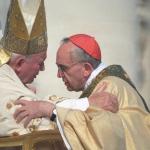
The Austrian political philosopher Eric Voegelin, in spite of his championing of a participation in a transcendent order, always cautioned against any political order that made any stipulations from a civic body that were in accordance with this participation. The mantra he used to describe this was a caution against “immanentising the eschaton“. Voegelin had reason to give this caution in this work, having been privy to the establishment of orders that, whether consciously or not, did promise to bring about such an order, and in so doing, close off the search for a genuine transcendence.
But what if the eschaton really was already here? Is there a way to immanentise that reality without a full blown imposition of that order from a political Mt. Sinai?
On today’s Solemnity of the Assumption of the Blessed Virgin Mary – celebrated in the East as the Dormition (sleeping) of the Theotokos – the Church makes its own contribution whereby the eschaton is drip-fed into history, with embodied persons acting as the gateways.
The Assumption, where Mary is taken up body and soul into heaven, is the second feast that puts on display the Church’s assertion that that Mary embodies the fruits of the saving power of God. The older feast of the Immaculate Conception, marking the beginning of Mary’s life where she is conceived without sin, puts on display the scope of Christ’s saving power, such that even chronological history is no barrier to erase the stain of sin. The Assumption, marking the end of her life, marks Mary’s embodying of the promise of an eschatological event – the resurrection of the body – as put down in the Anglican and Roman Catholic joint mariological declaration, Mary: Grace and Hope in Christ.
In the Assumption, Mary sends an embodied signal to all Christians on what the eschatological hope that they articulate each time they say in the Creed “I believe in…the resurrection of the dead”. That eschatological event is brought into history in the body of Mary.
It should be noted that Mary is not the only figure to be taken up into heaven without separation of the soul from the body. Though tempered by a healthy dose of Evangelical biblicism, Susannah Black of Radio Free Thulcandra gave a reminder over a chat that in the Old Testament the patriarch Enoch (Gen 5:24), and the prophet Elijah (2 Kg 2:11) were both taken without any mention of a bodily death. Furthermore, though Mary embodies in two ways the kind and scope of God’s saving action, she is not unique in the Catholic tradition of embodying that inbreaking of the eschaton through the narrow gate of the body.
In paragraph 52, Mary: Grace and Hope in Christ suggests that Paul’s confidence in the eschatological promises made in his epistles stem from the fact that he sees history from the standpoint of the eschaton, with the epistles an inbreaking of that eschatological perspective back into history. The special place of the prophets in biblical revelation is best expressed by Rabbi Edward Feld in his book on the Psalms Joy, Despair and Hope. The prophets, Feld writes, confuse the tenses and speak of the future in the present tense because they experience in their bodies the future promises of God. Finally, in the medieval period, St. Bonaventure did more than suggest in his Life of St. Francis that Francis of Assisi, because of his conformity to Christ, became a gateway for the entry of an eschatological order which he termed “Seraphic”.
In all these examples, and particularly in the example of Mary, we see bodies are bringing with them a slow weaving of the threads of the end of history into the fabric of history, though it is yet to be immanentised into a full blown order, marked not merely by God’s civic dominion, but by the praise of the heavenly and temporal orders in a cosmic liturgy.
















